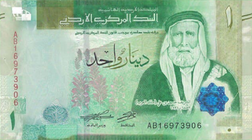
Back دينار أردني Arabic دينار اردنى ARZ Dinar xordanu AST İordaniya dinarı Azerbaijani Іарданскі дынар Byelorussian Ярданскі дынар BE-X-OLD Йордански динар Bulgarian জর্ডানীয় দিনার Bengali/Bangla জর্ডানিয়ান দিনার BPY Jordanski dinar BS
| دينار أردني / JOD (Arabic) | |
|---|---|
 Obverse of 1 Jordanian Dinar (5th Edition-2022) | |
| ISO 4217 | |
| Code | JOD (numeric: 400) |
| Subunit | 0.001 |
| Unit | |
| Symbol | د.أ |
| Denominations | |
| Subunit | |
| 1⁄10 | dirham |
| 1⁄100 | qirsh or piastre |
| 1⁄1000 | fils |
| Banknotes | 1, 5, 10, 20, 50 dinars |
| Coins | 1, 5, 10 piastres/qirsh, 1⁄4, 1⁄2 dinar |
| Demographics | |
| Official user(s) | |
| Unofficial user(s) | |
| Issuance | |
| Central bank | Central Bank of Jordan |
| Website | www |
| Valuation | |
| Inflation | 1.35% |
| Source | The World Factbook, 2021 est. |
| Pegged with | US dollar[1] US$ = JD 0.708 (buy) US$ = JD 0.71 (sell) |
The Jordanian dinar (Arabic: دينار أردني; code: JOD; unofficially abbreviated as JD) has been the currency of Jordan since 1950. The dinar is divided into 100 qirsh (also called piastres) or 1000 fulus. Fils are effectively obsolete; however, monetary amounts are still written to three decimal places representing fils. It is pegged to the US dollar.
The Central Bank of Jordan commenced operations in 1964 and became the sole issuer of Jordanian currency, in place of the Jordan Currency Board.
The Jordanian dinar is also widely used in the West Bank alongside the Israeli shekel.[2][3]
- ^ "Exchange rates of major foreign currencies announced by CBJ". Retrieved 14 June 2016.[permanent dead link]
- ^ Zacharia, Janine (2010-05-31). "Palestinian officials think about replacing Israeli shekel with Palestine pound". The Washington Post. ISSN 0190-8286. Retrieved 2018-08-22.
- ^ Cobham, David (2004-09-15). "Alternative currency arrangements for a new Palestinian state". In David Cobham (ed.). The Economics of Palestine: Economic Policy and Institutional Reform for a Viable Palestine State (PDF). London: Routledge. ISBN 9780415327619. Retrieved 2018-08-22.
© MMXXIII Rich X Search. We shall prevail. All rights reserved. Rich X Search